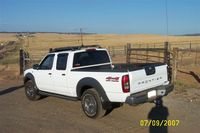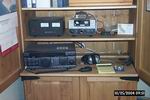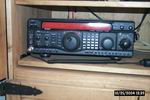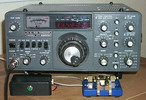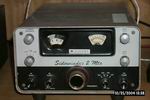AD6IL / KE6IOE Ham Radio Page
July 08, 2025 02:31 AM
Base and Mobile Stations
Here are a couple of pictures from my Infiniti I30 installation that I had
before the truck. At the time my mobile rig was a Yaesu FT-100 which was very
faithful for about 6 years of the commute before it finally lost 2m capability.
Now I have it for HF use in my camping trailer.
Other radios include a Yaesu FT-570 HT which I've had since getting my license and several Alinco handhelds (DJ-S11T, DJ-C5T, DJ-190 and DJ-195 and DJ-F1). I use the DJ-190 for APRS using either a TinyTracker-III or an Open-Tracker with a Trimble ACE-II GPS module. I also have a Kenwood TS-430 HF rig for backup and an Icom IC-202 portable 2m SSB radio. One of my favorite activities at this time is operating 2-meter sideband. I suggested we start up a Sacramento 2m SSB rag chew group on Saturday evenings at 9:00 PM on 144.200. Our first session was held on September 10, 2005 and I think there has been someone there every week. It later moved to 8:00 PM on 144.225 but now you can almost always find someone listening there. If you tune up and don't hear any activity, give a holler. Someone will almost always come back to you. Here is my page for the group. APRSAs noted above, I've been running APRS now when mobile for a couple of years. I do a 300 mile round-trip commute 2 days a week so I'm on the road quite a bit. I've been running the Byonics TinyTracker-III pretty much the whole time but have recently received my TinyTracker-IV beta kit to start building (today is 5/2/07). If you go back to my home page and scroll down a bit you should see a number of links to show my position and track. Projects
I also built and operate a 38-Special 30m QRP rig. The 38-Special was a kit from the Norcal QRP club. Here is a picture of my 38-Special which I built into a hard disk case and my Norcal paddle kit. The St. Louis Vertical is an antenna project that has been out on the web for some time. Verne Wright sells upgrade kits which is a coil assembly and base connector unit. Here's my attempt at making the same thing. Picture of coil. Here is my on-line CW log. (Its tiny now but hopefully it will grow over time.) I had such a hard time keeping this log up to date, I've started working on a logging program that uses a database with a web front-end. It is written in PHP using a MySQL database. I hope to have it on-line here before too long. Mitac GPS
Another ham-related project has to do with GPS. One of our local club members came across a number of very inexpensive GPS units by a company called Mitac. I was very interested in figuring out how to make this GPS work with APRS so I started digging. It turns out that the GPS is based on SiRFStar GPS module by SiRF Technologies. SiRF GPS modules have a proprietary language. I was unsuccessful getting any help from SiRF Technologies. However, a bunch of searches on the Web finally turned up a piece of a document that described enough of the language to do something useful. The most interesting thing I discovered was that SiRF modules can talk in the standard GPS language; NMEA. You just had to know how to ask the module to change modes. I first wrote a PC application (Windows) to change the mode and display NMEA strings as the GPS sent them. I later made this into a nicer program with a real graphical user-interface and a lot more functionality. Here is a link to the latest version. I also wrote a small program for the PalmPilot that allows you to switch the Mitac GPS into NMEA mode so it can be used with other PalmPilot programs. Here is a separate page on interfacing the Mitac GPS to the PalmPilot. |
